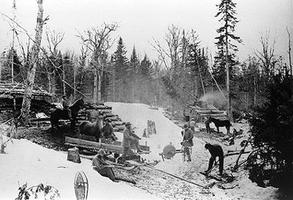A shanty is a winter lumber camp. The term is derived from the French Canadian word for lumber camp, "chantier." Early camps were simple, made of notched pine or spruce logs with a flat roof of rough shingles or bark and poles. By the 1840s larger "camboose" shanties could accommodate over 40 men in their 110 or 140 m2. The central fire, with its large open chimney for light and ventilation was not replaced by the stove until late in the century. Men slept fully clothed in bunk beds of hay or boughs. Cooking facilities, the foreman's office, barrels of wash water and grindstones occupied much of the remaining space.
See also Timber trade history.

 Share on Facebook
Share on Facebook Share on X
Share on X Share by Email
Share by Email Share on Google Classroom
Share on Google Classroom


